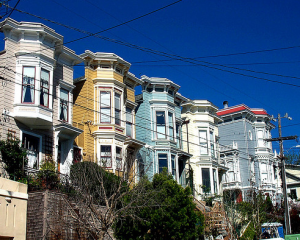<!–
Home News Bay Area Real Estate Price Gains Driven by Major Supply-and-Demand Shift
–>
By Brandon Cornett | January 18, 2013
© 2012, All rights reserved
<!–
Trending: Mortgage Rates are Rising
On August 16, 2012, the average rate for a 30-year fixed mortgage rose to 3.62%. What kind of rate can you get?
- Conventional:
- FHA:
Follow @mortgagechirp
!function(d,s,id){var js,fjs=d.getElementsByTagName(s)[0];if(!d.getElementById(id)){js=d.createElement(s);js.id=id;js.src=”//platform.twitter.com/widgets.js”;fjs.parentNode.insertBefore(js,fjs);}}(document,”script”,”twitter-wjs”);
–>

Vicksburg Street in San Francisco. Photo by Allan Ferguson.
At a glance: The median home price for the San Francisco Bay Area rose by 32% over the last year or so. It’s the result of inventory decline, job growth, and stronger optimism among consumers.
I’ve been giving California homeowners mostly bad news for a long time. After all, San Francisco was one of the hardest hit cities during the housing crisis. Just look at this free fall from 2006 – 2009.
It’s nice to have some good news for a change.
The median home price in the nine-county Bay Area rose by 32% in 2012, according to the latest figures by DataQuick. And current trends suggest we could see additional price gains in 2013.
Good Year for Bay Area Real Estate Prices
In December 2011, the median home price in the San Francisco Bay Area was $335,500. A year later, in December 2012, the median price had risen to $442,750 — a gain of 32%. According to DataQuick, a San Diego-based data firm, that was the largest year-over-year price gain since they started tracking them in 1988.
Some of this has to do with market shift. In the wake of the housing crisis, most of the Bay Area sales activity occurred on the lower end of the pricing spectrum. Low-cost distressed properties (read ‘foreclosures’) were the order of the day back then. In more recent months, however, activity has shifted toward the mid-market and move-up homes, according to DataQuick.
Overall market improvements have played a major role as well. Real estate inventory has plummeted in most parts of the Bay Area over the last year. Meanwhile, demand for housing has risen among both investors and live-in buyers. Supply and Demand 101: When there is less of the former and more of the latter, prices tend to rise. And when these factors shift considerably in a short period of time, as they have in the Bay Area real estate market, we see things like a 32% rise in median home prices.
Investors, Inventory and Home Prices
Inventory has a lot to do with this. According to data from Realtor.com, the San Francisco metro area had one of the largest reductions in for-sale inventory over the last year or so. The number of homes for sale dropped by 43% from December 2011 to December 2012. Out of the 146 metropolitan areas tracked by Realtor.com, San Francisco had the sixth highest year-over-year reduction in inventory.
Interestingly, nine of the top ten cities for inventory reduction were in California, but that’s another story.
Another positive trend: San Francisco recently had the largest decline in foreclosure filings, among the nation’s largest metro areas. A reduction in foreclosure inventory bolsters property values in two ways. It affects the overall balance of supply and demand. It also prevents pricing data from being unnaturally skewed by a high level of distressed homes (something that has plagued the city in previous years).
Much of this is the result of investment activity. Investors began pouring into the Bay Area real estate market a couple of years ago. They sensed the ‘bottom’ of the housing market and were eager to snatch up bargain properties, before appreciation wiped out their profit margins. Above all else, this is what drove inventory down the most.
At the same time, the economy as a whole was slowly improving (see employment notes below). So housing demand grew among regular home buyers as well, those who plan to live in their homes. We can probably expect more of this in 2013, though annual price gains will likely be more modest than last year.
More Jobs Equals More Buyers
Nothing fuels a housing market like job growth. This is another area of improvement. The unemployment rate for the San Francisco-Oakland-Fremont metro area fell to 7.5% in November 2012, down from a high of 10.6% in July 2010.
Granted, 7.5% is nothing to brag about. But the overall trend is undeniably positive. Job growth puts more people in a position to buy a home. It increases housing demand, and at a time when inventory is more limited than it was two or three years ago.
All of these trends seem to be having a positive effect on home buyers’ attitudes. The California Association of Realtors recently published the results of their 2012 survey of California home buyers.
According to the report: “Home buyers were more optimistic about future home prices than buyers in 2009. Nearly a quarter (23 percent) of them believed that home prices in their neighborhood will go up in one year, as compared to 8 percent in 2009.”
<!–
Filed under San Francisco Housing News
–>
Article source: http://www.homebuyinginstitute.com/news/bay-area-home-298/
